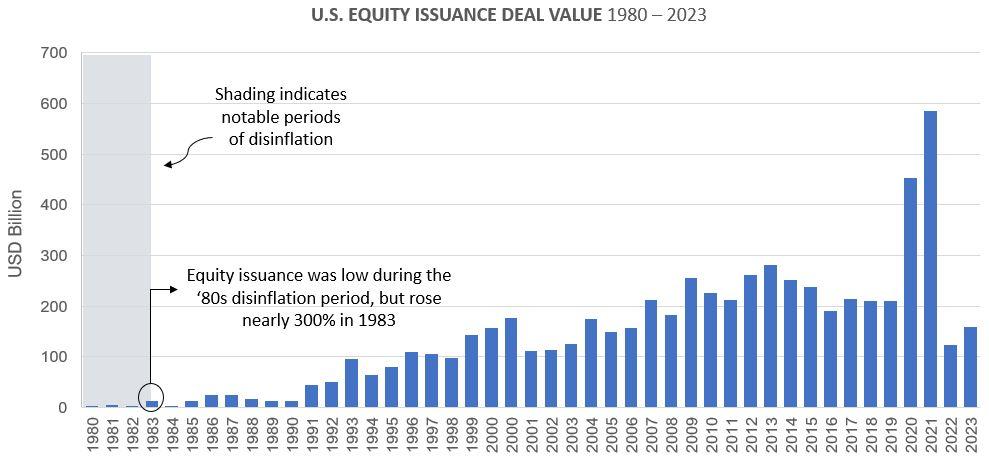Disinflation – The How and Why of it
Published on 18 Jan, 2024

In economics, fluctuations in inflation rates can significantly influence the financial landscape of businesses. While inflation tends to erode purchasing power, disinflation – a slowdown in the rate of price increases – presents a different set of challenges, particularly for companies seeking financing. As disinflation alters market dynamics, it can have positive and negative repercussions for businesses. Understanding these implications is crucial for navigating the intricacies of corporate finance and strategizing for sustainable growth.
Disinflation, often misconstrued as deflation, represents a decline in the rate of inflation, resulting in lower price increases for goods and services. This phenomenon, though seemingly favorable for consumers due to the increased purchasing power, can pose tricky challenges for businesses reliant on borrowing and investing for expansion and innovation. Deflation, on the other hand, is a negative inflation rate such as the one the U.S. experienced at the end of the Global Financial Crisis in 2009.

Source: Aranca Research
Disinflation’s Impact on Company Financing
Many factors influence capital markets, such as technological advances, monetary policy, and regulatory changes. With this caveat in mind, history signals that debt and equity issuance expands after a period of disinflation.
Impact on Borrowing Costs and Debt Servicing
One of the primary implications of disinflation for companies lies in its effect on borrowing costs. With decreasing inflation rates, lenders may perceive reduced risks in lending, resulting in a potential decline in interest rates. While this might seem advantageous, the actual impact can be multifaceted. Companies relying heavily on fixed-rate debt might find themselves locked into higher interest rates, leading to increased debt servicing costs relative to the prevailing market rates. Furthermore, renegotiating existing debt terms could become a daunting task, potentially impacting the overall financial health of the company.
As interest rates dipped and debt capital markets matured, issuing debt became cheaper and corporations seized this opportunity. Moreover, debt issuance was influenced by other factors, such as the maturity of the high-yield debt market and growth in non-bank lenders such as hedge funds and pension funds.

Source: Bloomberg, Dealogic, Federal Reserve, SIFMA, Refinitiv
Note: Data reflects U.S. debt issuance dollar volume; Interest Rate is the 10-year Treasury yield; as on June 20, 2023
Impact on Equity Issuance and Investor Sentiment:
Companies issued low levels of stock during the ‘80s disinflation period, but issuance later rose nearly 300% in 1983. Other factors also influenced equity issuance, such as macroeconomic expansion, productivity growth, and the dotcom boom of the ‘90s.
Disinflation can considerably influence investor sentiment and consequently impact stock performance. Investors often gauge a company's performance relative to the prevailing economic conditions. In disinflationary environments, investors might perceive companies as having lower revenue growth potential, leading to decreased market confidence and a subsequent dip in stock prices. Maintaining investor trust and effectively communicating the company's strategic initiatives become paramount during such periods to mitigate the potential negative impact on stock performance.

Source: Bloomberg, National Bureau of Economic Research
Note: As on 1 December 2023
Things to Consider During Disinflation:
Amid uncertainty in financial markets, lenders and investors may be more cautious. Companies would need to be strategic about how they approach capital financing.
- High-quality, profitable companies could be well positioned for IPOs as investors are increasingly emphasizing cash flow.
- High-growth companies could face fewer options as lenders become more selective and could consider alternative forms of equity and private debt.
- Companies with lower credit ratings could find debt more expensive as lenders charge higher rates to account for market volatility.
As disinflation alters the dynamics of capital markets, companies might have to recalibrate their financing strategies and capital expenditure plans. The reduced cost of borrowing could present an opportune moment for strategic investments and expansions. However, companies must carefully assess the potential long-term impacts and align their investment decisions with evolving market trends and consumer preferences. Adapting to the changing landscape while ensuring a sustainable and resilient financial structure is imperative for long-term success.
In conclusion, while disinflation may initially seem favorable for consumers, its implications for company financing can be far-reaching and complex. By understanding the nuanced interplay between borrowing costs, investor sentiments, and strategic financial management, companies can navigate the challenges posed by disinflation and position themselves for resilient and sustainable growth in a constantly evolving economic landscape.
